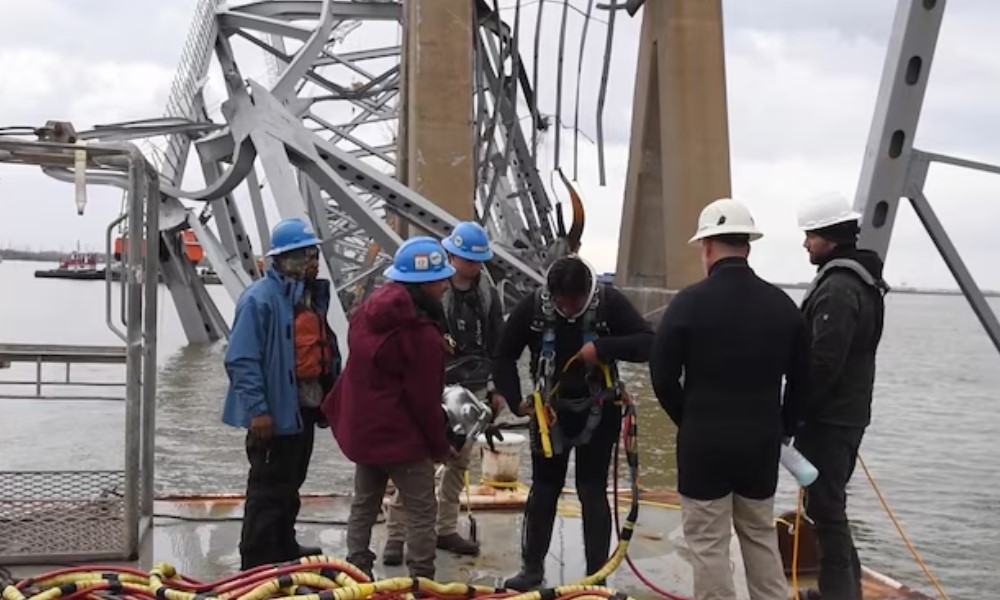Baltimore divers describe bridge clean-up operation as 9/11 ‘with blinders on’

A diving expert from the US Army Corps of Engineers (USACE) has revealed the many life-threatening risks divers are facing while working on the wrecked Francis Scott Key Bridge in Baltimore.
USACE, in a joint effort with the US Navy’s Supervisor of Salvage and Diving (SUPSALV), is working to oversee the commercial dive companies performing underwater work on the collapsed bridge.
Rick Benoit, emergency management specialist at the USACE North Atlantic Division (NAD) and lead dive expert at the division, said that the work on the Francis Scott Key Bridge collapse was an unusual mission with work in dark and cold water.
He emphasised that “divers are moving as if playing an underwater game of Twister and Jenga with hundreds of tons of shattered concrete and twisted steel in complete darkness” and that if they fail the price could be severe injury or death.
If the divers don’t proceed with caution, they may be impaled by rebar, cut by jagged steel, or be hit by falling, broken pieces of heavy concrete and asphalt, causing them to be trapped or drowned.
“It may sound dramatic but given the wreckage field created by the collapsed bridge the environment divers are working in and the dangers posed to them is like cleaning the site of 9/11 with blinders on,” Benoit added.
The safety of the divers is multiplied by the conditions in the water as the visibility is only one to two feet in front of them. Even with LiDAR and advanced sonar imaging helping to map underwater routes some elements of the wreckage can’t be completely detected. Rebar, for example, can’t be located by sonar.
What takes a person on the surface to do in one hour can take up to 10 hours to do underwater
Regardless, these dives are critical. Before the wreckage can be moved with cranes, divers need to survey and investigate the safest methods to remove it from the water.
The bottom of the Patapsco River is also dangerous as it is muddy, silty, and filled with wreckage. If divers tried to stand on it, they could sink in and potentially injure themselves on fragments of metal or concrete.
Apart from all that, the time divers can spend in the water is not more than an hour due to the water temperature and water pressure. Since the start of the operation, water temperatures have stood around 8 degrees Celsius, cold enough to cause hypothermia after an hour in the water. Also, the divers in Baltimore are diving as far down as 15 meters. In a typical dive at that depth, a person would have around 92 minutes. As a safety measure, divers there are restricted to 45 minutes underwater.
Staying longer than the advised times also increases the risk of decompression sickness. When a person comes up too fast, the body is not able to process the larger quantities of air that come with the change in water pressure which can even lead to an arterial embolism. As an emergency precaution, recompression chambers sit on barges onsite.
“It’s like your body, specifically the lungs, are a balloon; if you ascend to the surface too fast, alveoli, or air sacks in the lungs, will rupture, spilling air bubbles into the circulatory blood system which can cause a diver to embolize,” Benoit said.
Furthermore, large steel beams from the collapsed bridge reaching from the surface to the bottom are too large and heavy to be picked up by cranes and must be cut first which is a problem in and of itself. There is also a risk the entire structure could move due to the release of force on that section of the beam.
“If you take a rubber band, twist it enough times and then cut it, what happens? It’ll snap back on you. The steel has been twisted in an opposite way than it was intended to exist. When you start cutting into it, it is like cutting a branch off a tree. You get to a certain point where inertia takes over and it snaps,” Benoit claimed.
“The enormity of this disaster is hard to imagine without seeing it in person. What takes a person on the surface to do in one hour can take up to 10 hours to do underwater,” he concluded.
To further accelerate the removal of collapsed steel from the bridge, USACE brought in the biggest crane barge on the East Coast to remove larger sections of the bridge. The barge, named Chesapeake 1000, removed a large section of the main span on Sunday which helped with clearing a limited access channel for smaller ships.
Furthermore, Maryland governor Wes Moore announced more assistance for those businesses and workers who rely on the Port of Baltimore including grants of up to $200,000 while the state’s Congressional delegation introduced legislation that would mandate the federal government pay for all the costs of a replacement bridge.
The National Transportation Safety Board recovered the Dali’s voyager data recorder last month, which showed power failed for just one minute and three seconds as it approached Baltimore’s largest bridge, and that the lead pilot tried to swing the 300 m long vessel clear of a collision by dropping its port anchor to pivot it away.
The disabled ship ran into a support pillar and caused much of the bridge to tumble into the Patapsco River at roughly 1:30 am on March 26. Just moments before, at 1:26 am, the pilot of the ship called for tugboat assistance, according to the voyage data recorder. At 1:27 am, the pilot made an order to drop the ship anchor.





